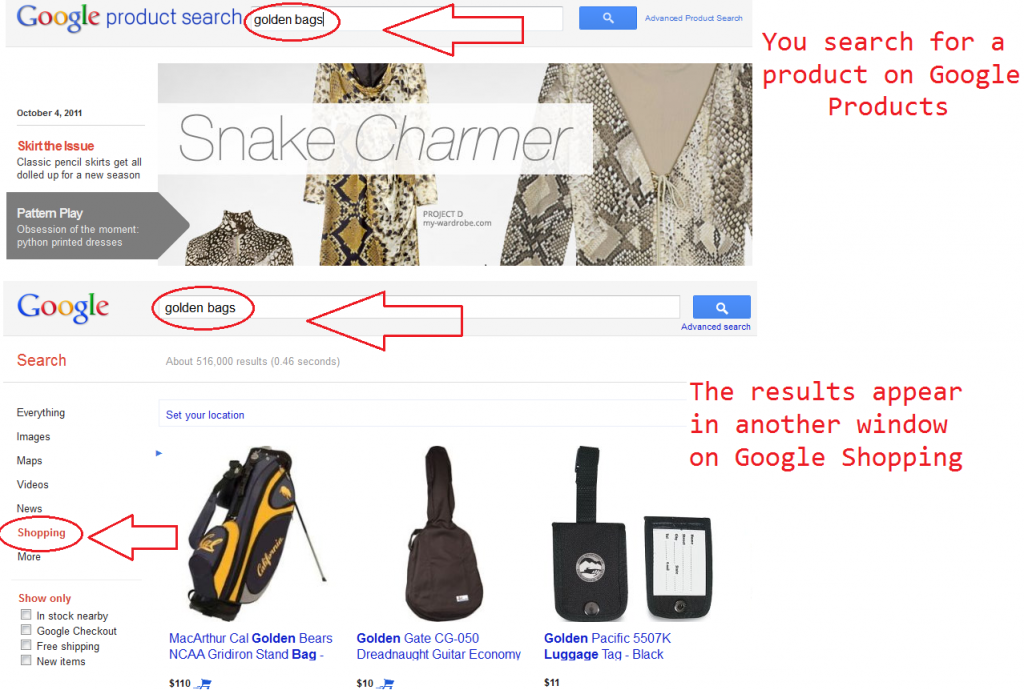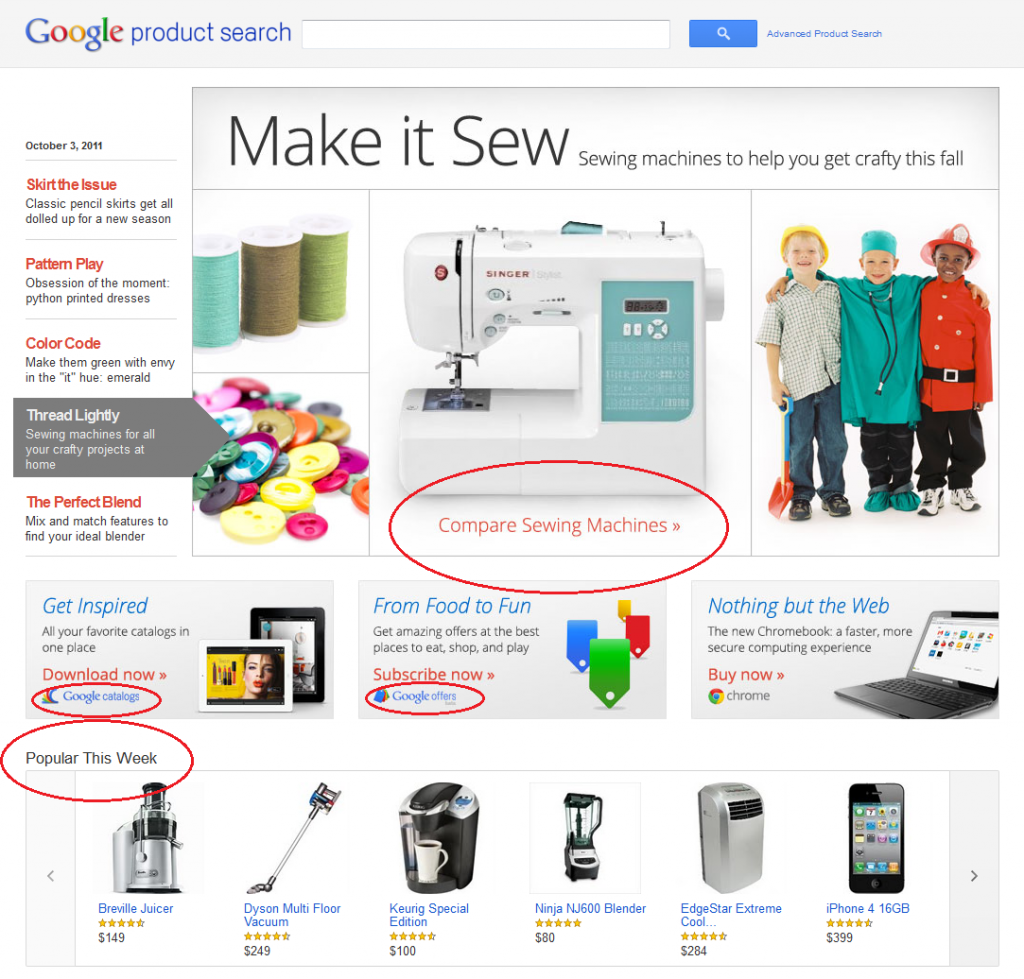 This post is for those who live and breathe Web commerce – e-commerce site owners, merchants who’d like to promote their shopping venues on the Internet, and similar folks.
This post is for those who live and breathe Web commerce – e-commerce site owners, merchants who’d like to promote their shopping venues on the Internet, and similar folks.
Google Base?
Many of you must have heard of Google Base. As Google is keen on restructuring and renaming its different services – what used to be called Google Base is now called Google Merchant Center. The service allows business owners to create listings of their products that will later appear on Google Product Search and will be included into Google’s Shopping search results.
Google Product Search and Google Shopping
Just to make things clear for you: Google Product Search is Google’s database of different products that are submitted by merchants through the Google Merchant Center. If you search the database for a particular item, the results will get displayed in Google’s Shopping search results.
Another thing is when those Shopping results (just the top 3 listings) get incorporated into Everything search results on Google.com if Google considers them relevant for a particular query. However, this feature that is called Local Shopping (Google serves you items that are being sold in your country) is only available to merchants targeting the following countries – the U.S., U.K., Japan, Germany, and France.
Google Checkouts
Another major service that should be considered in regards to Google Shopping is Google Checkouts – a popular Google-powered shopping cart platform that, in addition to being a shopping cart, also allows users to review products and services.
Why bother optimizing for Google Shopping?
All in all, Google Shopping is not as popular with SEO-optimizers as Google Places, so, some SEO’s do not even bother optimizing for Google Shopping.
However, we believe that, in the nearest future, Google Products search will become more widely used than it is used now. What points to that?
-Google Products homepage has been recently redesigned and now offers one to compare different categories of products in a hit, contains snippets from Google Catalogs and Google Offers, has a “Popular This Week” section and other sections.
-Google has just launched the much talked-about Google Wallet. Google Wallet makes shopping easier than it has ever been before. It’s now unclear how Google Wallet will interact other Google’s services, but Google have already said it is possible that, in the future, “receipts, boarding passes and tickets will all be seamlessly synced to your Google Wallet.” Why not expect Google to incorporate Google Product Search into Google Wallet as well?
Where do I start?
So, say, there is something that you’d like to promote on Google Shopping. Where do you start? First off, you need to set up a Google Merchant Center account.
1. Get an account with Google Merchant Center
Here is where you can sign up for a Google Merchant Center account.
You have to provide:
- Website URL (needs to be verified and claimed)
- Store name (must conform to the service’s guidelines)
- Business name and address
- Country and region of your business (cannot be changed later)
- Contacts
You can also get a multi-client account (for big e-commerce portals), in which case each vendor will be able to have a distinct store name and URL. You can request a multi-client- account here.
To find out whether Google Product Search and Google’s Local Shopping is available for the country/countries you are targeting, have a look at the following chart:
| Country | Google Product Search available | Google Local Shopping available |
|---|---|---|
| U.S. | Yes | Yes |
| U.K. | Yes | Yes |
| Germany | Yes | Yes |
| Japan | Yes | Yes |
| France | Yes | Yes |
| Australia | Yes | No |
| China | Yes | No |
| Italy | Yes | No |
| Spain | Yes | No |
| the Netherlands | Yes | No |
Please, note that to make your products appear in Google’s Local Shopping results, your business has to be listed on Google Places.
*A tip for those targeting the countries where Google Product Search is not available yet – optimize for Google Images! Ranking highly in the Images search results can attract lots of customers to your site.
2. Prepare product data feeds
A product data feed is a structured description of your product that’s normally submitted in a particular format. First, make sure that the products you’d like to submit are eligible for submission. Then, check for the requirements to product listings in specific countries.
When preparing your product feed, fill out as many fields as you can. It is believed that the more information you provide about a product, the better it will rank on Google Shopping. Now, some things to pay attention to:
- You can target several countries. The target country is specified right in your feed. Please, do not confuse the country/countries you are targeting with the country your business is associated with (this one is specified while signing up for a Google Merchant Center account).
- You are not allowed to use redirects or pop-ups on the landing page associated with the product you are submitting
- On the landing page associated with your product, the submitted product must stand out
- No promotional language is allowed in a data feed
- It’s recommended to use your main branded or your main non-branded keyword in your product’s title, if appropriate
- Remember to make your product’s description keyword-rich (but not keyword-stuffed!)
- The price on the landing page has to be equal to the price in your feed
3. Submit your product data feeds to Google Merchant Center
For that you need to upload your feeds through your Google Merchant Center account. It’s recommended to upload a test feed first, and then submit a regular product data feed for review.
Also, Google says that it may take several weeks for first-time feeds to go live in the search results if you are submitting them to other locales than the U.S., U.K. and Germany.
Here are some product data feed requirements to help you upload your feeds without errors.
4. Add Google Checkouts to your site
If possible, integrate http://checkout.google.com/seller/integrate.html your site with Google Checkouts. As I said above, it is Google-powered shopping cart software. Well, what does it do for your site? First, if your site accepts Google Checkouts, a small blue shopping cart icon will be appearing right next to your listing in Google’s Shopping search results. This may boost your conversions substantially.
However, the biggest advantage of Google Checkouts is that, once a shopper places an order, Google sends them an invitation to review the seller.
Also, here is what Google charges you for using the service.
5. Get rated and reviewed
Getting ratings and reviews of your products is key to higher Google Shopping rankings. Google considers ratings/reviews from Google Checkouts and other third-party sites, such as ResellerRatings.com,TrustPilot.com, Epinions.com, BizRate.com or RateItAll.com, to give your listing a particular ranking.
Snippets of those ratings/reviews are displayed along with your product, and its average rating is calculated. However, for your product’s rating to EVEN APPEAR on Google Shopping, it needs to have at least 30 unique reviews, associated with your store name and the name of your domain.
What if someone posts a review that does not sound fair at all? Unfortunately, you can’t reply to reviews right on Google Product Search. But you can contact the rating/review site in question. If the review gets removed, it might take some time for the changes to be visible on Google Shopping.
6. Track clicks and impressions
Within your Google Merchant Center account, you can see the number of impressions and clicks each of your product listings receives.
7. Update your product info at least once in 30 days
Thing is, all your products expire after 30 days. So, a product data feed for each product needs to be submitted as least once every 30 days.
Other useful resources to check out:
Google’s E-commerce YouTube Channel
Google’s Commerce Blog.







October 13, 2011
Great post. All ecommerce merchants need to be taking advantage of this free traffic source.
Sometimes building the data feed can be tricky though. There are a lot of requirements and some of them don’t make sense.
Check out this article on how the Google Shopping shipping requirement is not being enforced:
http://searchenginewatch.com/article/2115655/Rule-Abiding-Merchants-Abandoned-by-Google-Product-Search
November 4, 2011
This is really nice 🙂 Thanks for sharing..
December 15, 2011
Hey well thought out article. Thanks!
January 2, 2012
E-commerce players does not pay much attention to this aspect of getting organic traffic. And google is also not very serious about this product. Else they would have killed comparison website by now.
June 28, 2012
Good article although a bit concerned considering I do not have the amount of reviews, if any to get on the listings.
Also my opencart store does not by default have google checkout and besides the buttons do not look that good anyway.
Thanks for the tips but I also read someone that this will no longer be available from October, in preference of a paid advertising solution.
Regards Jack
August 13, 2012
That’s right. This is what I heard, too. And reading today’s article, there can be no more doubt as to the imminent transition from free to paid Google Shopping – http://searchengineland.com/google-shopping-%E2%80%93-the-balance-between-old-new-129011